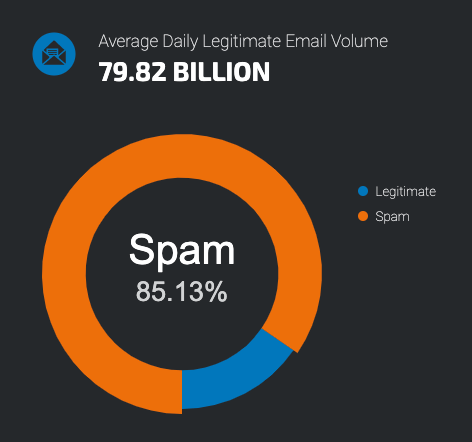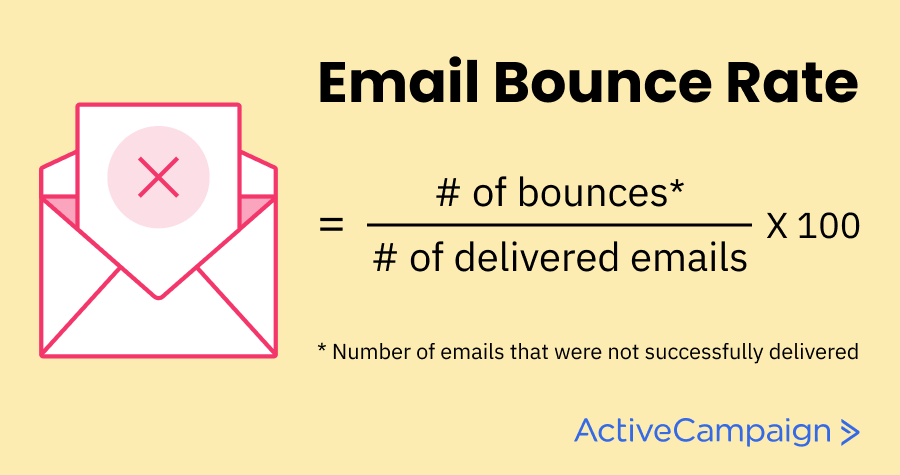
Email bounces happen to everyone. It’s important to understand what they are and why they occur, because your email marketing success depends on if your messages reach recipients’ inboxes.
In this article, you’ll learn:
- What is a bounce back email?
- What causes an email to bounce back?
- How can you reduce your bounce back rate?
What is an email bounce?
An email bounce (or “bounce”) is an error message you get when an email you’ve sent isn’t delivered. Your email server or the destination mail server sends this Non-Delivery Report (NDR). An email bounce message also informs you what caused the delivery failure of your email.
You might think bouncing is fun, but your emails sure don’t.
To understand bounce back emails it helps to first answer: what are the steps to deliver an email?
- You address an email by filling out the “From” and “To” fields and click the “Send” button
- Your email is given to your SMTP (Simple Mail Transfer Protocol) server for delivery. Think of your SMTP as a local post office.
- The SMTP server checks your email with the DNS (Domain Name Server). The DNS is an address book for domain names and server IP addresses.
- Once your recipient’s server is located, the SMTP server gives your message to their MTA (Mail Transfer Agent) to complete email delivery. The MTA is the postman in this scenario.
- Your email is delivered successfully to your recipient’s inbox
But sometimes, the last step doesn’t go as planned. Instead, what happens is:
- An internet meme dog intercepts and eats your email before it’s successfully delivered
Okay, that’s not what happens at all, though a bounced email message might feel like that. Luckily bounce backs have clear causes…and are often an easy fix.
What causes an email to bounce back?
There are a variety of reasons that an email message can bounce: the email address doesn’t exist, the inbox is full, server outages, poor sender reputation due to spam complaints, flagged content in the message content, or a restrictive DMARC record for your sending domain.
There are many reasons you receive a delivery status notification that an email bounced (even more than the above list).
Those reasons can be temporary — but others are permanent. You will know how to troubleshoot email bounce backs if you first understand the type of bounce category your email falls under.
The three types of bounce backs (aka types of email bounces) that disrupt the delivery of your email are:
- Soft bounce emails
- Hard bounce emails
- Blocklisted emails
 Tip: don’t delete your bounce back email! Tip: don’t delete your bounce back email!
Keep your bounce back email to understand why the message bounced. Emails bouncing back include Simple Mail Transfer Protocol (SMTP) error code numbers. Mailbox providers can include messages to explain the codes…or provide no message at all. You need to read them carefully to understand your particular bounce reason. |
1. Soft bounce emails
Emails soft bounce when a server rejects an email temporarily. This is a temporary issue and most email services try to resend email messages after they soft bounce.
Reasons for a soft bounce include:
- Mailbox full: If a recipient has too many emails and reaches capacity, your email will bounce back until there’s free space
- Email size: If you pack emails with megabyte-heavy images or include a huge attachment, it might be bounced back if there’s a filter in place
- Server is down: An unreachable server may have crashed, been overloaded, or been under maintenance. This means you must wait to send the email to the address again.
- Autoreply: If someone goes on vacation and sets an auto-reply, your email will often bounce back
2. Hard bounce emails
A hard bounce happens when your email is permanently undeliverable to an email address.
Reasons for a hard bounce email include:
- Fake email address: Some people give fake email addresses. The likelihood rises when you ask for an address in exchange for something online, like content or a discount. Using double opt-in can help avoid these bounces.
- Incorrect email address: There’s no spell check in email address fields — typos happen!
- Email blocked: Some sender domains (like governmental or institutional) have stricter spam filter settings. Or (sad but true) the recipient may have purposely blocked your email address. If it’s the former, ask them to add you to their contacts.
You can’t fix hard bounce email issues. What you can do is remove hard bounced email addresses from your mailing list. If you don’t and they start to pile up, you run the risk of your emails being blocklisted.
3. Blocklisted emails
Nearly 85% of emails sent daily are considered spam.
Email blocklists are created by ESPs (email service providers) to filter harmful or exploitative content, like spam or malware. They don’t exist to make it harder for you to send emails — they exist to protect the recipients of the almost 300 billion emails sent daily.

Email and spam statistics for June, 2019 (Source: Cisco Talos)
Why do emails get blocklisted? It usually happens because of:
- Spam complaints: The rare complaint is unwelcome but expected. But if complaints reach a certain level, ISPs can send your emails to spam folders or a blocklist.
- High bounce rates: If you don’t have good email list hygiene, your bounce rates might start to pile up
- A surge in list size or email volume: If your list grows too fast, it’s a red flag that you may have bought a list. If you start to send massive amounts of emails, it may signal spam.
- Bad content: If you use spammy words in your subject line like “FREE” in all caps followed by 17 exclamation points, stop now. Here are the types of emails you should be sending.
Being placed on a blocklist can range from being a minor annoyance — or it might mean your email campaign is not delivered to any of your subscribers.
Large ISPs may have their own blocklists. However, the most popular lists are publicly available, and used by email providers and businesses worldwide.
How do you get off a blocklist?
- With time: You may be removed from a blocklist automatically after a predetermined period of time
- Contact the blocklist: Submit a request to the blocklist holder’s website to be delisted
- Maintain list hygiene: Remove dead-end addresses that have hard bounced — and never, ever buy an email list
- Provide value: Send emails with relevant content to engage subscribers and avoid spam complaints
- Change your ISP: If the IP assigned to you is compromised, change providers to stay off blocklists
 Tip: Never buy a list of email addresses. Tip: Never buy a list of email addresses.
Buying a list of email addresses might seem like a great shortcut to get eyes on your marketing message — but can lead to no one seeing your emails.
You can’t buy good lists. But you can grow them. |
If you find yourself on a blocklist, it might mean something is wrong in your email marketing. The odds that you’ll be mistaken for spam and put on a blocklist rise if you use email blasts. You probably use email blasts wrong, but you don’t have to.
Blocklists are scary, but they aren’t forever. If you follow the right steps to get off blocklists, you can then avoid them in the future.
Read our blog post on email blocklists to resolve more blocklist issues like:
- How do you know if you’re on an email blocklist?
- How do you stay off email blocklists?
- If you’ve been on a blocklist, what does that mean for you?
How do you reduce email bounce rate?
An email bounce rate is the percentage of your emails that bounce back as undeliverable. Email bounce rate is calculated by taking the number of email bounces divided by the number of delivered emails and multiplying by 100.
Unlike other email marketing metrics like clicks and opens, where a high rate = good, a high message bounce rate is bad. You want to keep your bounce rate as low as you can.

Calculating your email bounce rate is important. Bounce rate shows you the health of your email deployments.
Bounce backs (especially hard bounces) damage your reputation. If your undeliverable email rate is high (above 5%), the negative deliverability will impact the success of your email campaign.
Even future campaigns.
That’s because email networks monitor bounce rate trends for all your current campaigns to decide if they’ll accept your email later on.
Aim to keep your email bounce rate less than 2%. Anything above that bounce rate for an email campaign needs your attention. Tweet this!!
Ways to keep your bounce rate low
- Clean your list: Identify and remove unengaged or abandoned email addresses on a regular basis. Check to see if your platform removes hard email bounces automatically.
- Permission-based lists: Only send emails to people who give consent to receive your campaigns. Decide if you want to use a double opt-in email process.
- Send emails regularly: Send emails to your list often (but not excessively). This leads to fewer spam complaints, higher engagement…and lower bounce rates.
- User preference center: Give subscribers control over what kinds of emails they get and how often they get them
- Authenticate emails: Authentication further strengthens your reputation. ActiveCampaign does this automatically.
- Use list segmentation: Segmentation improves your marketing. Email your most engaged customers first. This shows the ESP’s spam filters that you have good content with positive engagement results.
Your goal is to reduce the number of bounces in your list.
Complete elimination is not possible. Bounces will still happen — email addresses are mistyped and servers go down for maintenance.
Control only the things you can control. Address email server issues (or other technical issues) as they pop up. Nurture your permission-based list. Send people the content they want to get from you.
The result will be high-quality marketing email campaigns guaranteeing your list won’t bounce out of your control.
{
“@context”: “https://schema.org”,
“@type”: “FAQPage”,
“mainEntity”: [{
“@type”: “Question”,
“name”: “What is an email bounce?”,
“acceptedAnswer”: {
“@type”: “Answer”,
“text”: “An email bounce (or “bounce”) is an error message you get when email you’ve sent isn’t delivered. Your email server or the destination mail server sends this Non-Delivery Report (NDR). An email bounce message also informs you what caused delivery failure of your email.”
}
},{
“@type”: “Question”,
“name”: “What causes an email to bounce back?”,
“acceptedAnswer”: {
“@type”: “Answer”,
“text”: “There are a variety of reasons that an email message can bounce: the email address doesn’t exist, the inbox is full, server outages, poor sender reputation due to spam complaints, flagged content in the message content, or a restrictive DMARC record for your sending domain.”
}
},{
“@type”: “Question”,
“name”: “How do you reduce email bounce rate?”,
“acceptedAnswer”: {
“@type”: “Answer”,
“text”: “An email bounce rate is the percentage of your emails that bounce back as undeliverable. Email bounce rate is calculated by taking the number of email bounces divided by the number of delivered emails and multiplied by 100.”
}
}]
}
https://www.activecampaign.com/blog/email-bounce






